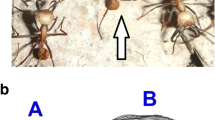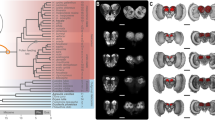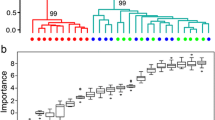Abstract
Shifts to new ecological settings can drive evolutionary changes in animal sensory systems and in the brain structures that process sensory information. We took advantage of the diverse habitat ecology of Neotropical army ants to test whether evolutionary transitions from below- to above-ground activity were associated with changes in brain structure. Our estimates of genus-typical frequencies of above-ground activity suggested a high degree of evolutionary plasticity in habitat use among Neotropical army ants. Brain structure consistently corresponded to degree of above-ground activity among genera and among species within genera. The most above-ground genera (and species) invested relatively more in visual processing brain tissues; the most subterranean species invested relatively less in central processing higher-brain centers (mushroom body calyces). These patterns suggest a strong role of sensory ecology (e.g., light levels) in selecting for army ant brain investment evolution and further suggest that the subterranean environment poses reduced cognitive challenges to workers. The highly above-ground active genus Eciton was exceptional in having relatively large brains and particularly large and structurally complex optic lobes. These patterns suggest that the transition to above-ground activity from ancestors that were largely subterranean for approximately 60 million years was followed by re-emergence of enhanced visual function in workers.







Similar content being viewed by others
References
Allman JM (2000) Evolving brains. Scientific American Library, New York
Barton RA, Harvey PH (2000) Mosaic evolution of brain structure in mammals. Nature 405:1055–1058
Barton RA, Purvis AA, Harvey PH (1995) Evolutionary radiation of visual and olfactory brain systems in primates, bats and insectivores. Philos Trans R Soc Lond B 348:381–392
Baudier KM, Mudd AE, Erickson SC, O’Donnell S (2015) Microhabitat and body size effects on heat tolerance: implications for responses to climate change (army ants: Formicidae, Ecitoninae). J Anim Ecol 84:1322–1330
Berghoff SM, Franks NR (2007) First record of the army ant Cheliomyrmex morosus in Panama and its high associate diversity. Biotropica 39:771–773
Brady SG (2003) Evolution of the army ant syndrome: the origin and long-term evolutionary stasis of a complex of behavioral and reproductive adaptations. Proc Natl Acad Sci U S A 100:6575–6579
Brady SG, Schultz TR, Fisher BL, Ward PS (2006) Evaluating alternative hypotheses for the early evolution and diversification of ants. Proc Natl Acad Sci U S A 103:18172–18177
Brady SG, Fisher BK, Schultz TR, Ward PS (2014) The rise of army ants and their relatives: diversification of specialized predatory doryline ants. BMC Evol Biol 14:1–14
Catania KC (2005) Evolution of sensory specializations in insectivores. Anat Rec A 287:1038–1050
Coody CJ, Watkins JF II (1986) The correlation of eye size with circadian flight periodicity of Nearctic army ant males of the genus Neivamyrmex (Hymenoptera; Formicidae; Ecitoninae). Tex J Sci 38
Dunn R (2003) Imposter in the nest. Nat Hist 112:22–26
Eberhard WG, Wcislo WT (2011) Grade changes in brain–body allometry: morphological and behavioural correlates of brain size in miniature spiders, insects and other invertebrates. Adv Insect Physiol 40:155–214
Fahrbach SE (2006) Structure of the mushroom bodies of the insect brain. Annu Rev Entomol 51:209–232
Farris SM (2008) Evolutionary convergence of higher order brain centers spanning the protostome deuterostome boundary. Brain Behav Evol 72:106–122
Farris SM, Robinson GE, Fahrbach SE (2001) Experience and age-related outgrowth of intrinsic neurons in the mushroom bodies of the adult worker honeybee. J Neurosci 21:6395–6404
Gotwald WH Jr (1995) Army ants: the biology of social predation. Cornell University Press, Ithaca
Gronenberg W (1999) Modality-specific segregation of input to ant mushroom bodies. Brain Behav Evol 54:85–95
Gronenberg W (2001) Subdivisions of Hymenopteran mushroom body calyces by their afferent supply. J Comp Neurol 436:474–489
Gronenberg W, Hölldobler B (1999) Morphologic representation of visual and antennal information in the ant brain. J Comp Neurol 412:229–240
Gronenberg W, Liebig J (1999) Smaller brains and optic lobes in reproductive workers of the ant Harpegnathos. Naturwissenschaften 86:343–345
Gronenberg W, Riveros AJ (2009) Social brains and behavior: past and present. In: Gadau J, Fewell J (eds) Organization of insect societies: from genome to sociocomplexity. Harvard University Press, Cambridge, pp 377–401
Gronenberg W, Heeren S, Hölldobler B (1996) Age dependent and task-related morphological changes in the brain and the mushroom bodies of the ant Camponotus floridanus. J Exp Biol 199:2011–2019
Hodos W, Butler AB (1997) Evolution of sensory pathways in vertebrates. Brain Behav Evol 50:189–197
Ilies I, Muscedere ML, Traniello JFA (2015) Neuroanatomical and morphological trait clusters in the ant genus Pheidole: evidence for modularity and integration in brain structure. Brain Behav Evol 85:63–76
Jeffery WR (2001) Cavefish as a model system in evolutionary developmental biology. Dev Biol 231:1–12
Jones TA, Donlan NA, O’Donnell S (2009) Growth and pruning of mushroom body Kenyon cell dendrites during worker behavioral development in the paper wasp, Polybia aequatorialis (Hymenoptera: Vespidae). Neurobiol Learn Mem 92:485–495
Kaspari M, Powell S, Lattke J, O’Donnell S (2011) Predation and patchiness in the tropical litter: do swarm‐raiding army ants skim the cream or drain the bottle? J Anim Ecol 80:818–823
Kuebler LS, Kelber C, Kleineidam CJ (2010) Distinct antennal lobe phenotypes in the leaf‐cutting ant (Atta vollenweideri). J Comp Neurol 518:352–365
Laughlin SB (2001) Energy as a constraint on the coding and processing of sensory information. Curr Opin Neurobiol 11:475–480
Lefebvre L, Sol D (2008) Brains, lifestyles and cognition: are there general trends? Brain Behav Evol 72:135–144
Mace GM, Eisenberg JF (1982) Competition, niche specialization and the evolution of brain size in the genus Peromyscus. Biol J Linn Soc 17:243–257
Moller AP, Erritzoe J, Garamszegi LZ (2005) Covariation between brain size and immunity in birds: implications for brain size evolution. J Evol Biol 18:223–237
Moreau CS, Bell CD, Vila R, Archibald SB, Pierce NE (2006) Phylogeny of the ants: diversification in the age of angiosperms. Science 312:101–104
Moser JC, Reeve JD, Bento JMS, Della Lucia TMC, Cameron RS, Heck NM (2004) Eye size and behaviour of day- and night-flying leafcutting ant alates. J Zool Lond 264:69–75
Mota T, Yamagata N, Giurfa M, Gronenberg W, Sandoz J-C (2011) Neural organization and visual processing in the anterior optic tubercle of the honeybee brain. J Neurosci 31:11443–11456
Muscedere ML, Traniello JFA (2012) Division of labor in the hyperdiverse ant genus Pheidole is associated with distinct subcaste- and age-related patterns of worker brain organization. PLoS One 7, e31618
Narendra A, Reid SF, Greiner B, Peters RA, Hemmi JM, Ribi WA, Zeil J (2011) Caste-specific visual adaptations to distinct daily activity schedules in Australian Myrmecia ants. Proc R Soc B 278:1141–1149
Navarrete A, van Schaik CP, Isler K (2011) Energetics and the evolution of human brain size. Nature 480:91–93
Nishikawa M, Watanabe H, Yokohari F (2012) Higher brain centers for social tasks in worker ants, Camponotus japonicas. J Comp Neurol 520:1584–1598
Niven JE, Laughlin SB (2008) Energy limitation as a selective pressure on the evolution of sensory systems. J Exp Biol 211:1792–1804
O’Donnell S, Lattke J, Powell S, Kaspari M (2005) Extraordinary predation by the Neotropical army ant Cheliomyrmex andicola: implications for the evolution of the army ant syndrome. Biotropica 37:706–709
O’Donnell S, Lattke J, Powell S, Kaspari M (2007) Army ants in four forests: geographic variation in raid rates and species composition. J Anim Ecol 76:580–589
O’Donnell S, Lattke J, Powell S, Kaspari M (2009) Species and site differences in Neotropical army ant emigration behavior. Ecol Entomol 34:476–482
O’Donnell S, Kumar A, Logan C (2010) Army ant raid attendance and bivouac-checking behavior by Neotropical montane forest birds. Wilson J Ornithol 122:503–512
O’Donnell S, Clifford MR, DeLeon S, Papa C, Zahedi N, Bulova SJ (2013) Brain size and visual environment predict species differences in paperwasp sensory processing brain regions (Hymenoptera: Vespidae, Polistinae). Brain Behav Evol 82:177–184
O’Donnell S, Bulova SJ, DeLeon S, Khodak P, Miller S, Sulger E (2015) Distributed cognition and social brains: reductions in mushroom body investment accompanied the origins of sociality in wasps (Hymenoptera: Vespidae). Proc R Soc B 282:20150791
Perfecto I (1992) Observations of a Labidus coecus (Latreille) underground raid in the central highlands of Costa Rica. Psyche 99:214–220
Rabeling C, Brown JM, Verhaagh M (2008) Newly discovered sister lineage sheds light on early ant evolution. Proc Natl Acad Sci U S A 105:14913–14917
Rehan SM, Bulova SJ, O’Donnell S (2015) Cumulative effects of foraging behavior and social dominance on brain development in a facultatively social bee (Ceratina australensis). Brain Behav Evol 85:117–124
Rettenmeyer CW (1963) Behavioral studies of army ants. Univ Kans Sci Bull 44:281–465
Schneirla TC (1971) Army ants: a study in social organization. W. H. Freeman, Oxford, England
Seid MA, Castillo A, Wcislo WT (2011) The allometry of brain miniaturization in ants. Brain Behav Evol 77:5–13
Sherry DF (2006) Neuroecology. Annu Rev Psychol 57:167–197
Smaers JB, Soligo C (2013) Brain reorganization, not relative brain size, primarily characterizes anthropoid brain evolution. Proc Biol Sci 280:20130269
Strausfeld NJ (2005) The evolution of crustacean and insect optic lobes and the origins of chiasmata. Arthoprod Struct Dev 34:235–256
Strausfeld NJ, Hansen L, Li Y, Gomez RS, Ito K (1998) Evolution, discovery, and interpretations of arthropod mushroom bodies. Learn Mem 5:11–37
Sulger E, Mcaloon N, Bulova SJ, Sapp J, O’Donnell S (2014) Evidence for adaptive brain tissue reduction in obligate social parasites (Polyergus mexicanus) relative to their hosts (Formica fusca). Biol J Linn Soc 113:415–422
Villareal DG, MacKay WP, Manriguez AR, Vinson SB (1995) New records for the ant Cheliomyrmex morosus in Mexico (Hymenoptera: Formicidae). J New York Ent Soc 103:219–220
Ward PS (2007) Phylogeny, classification, and species-level taxonomy of ants (Hymenoptera: Formicidae). Zootaxa 1668:549–563
Weber NA (1941) The rediscovery of the queen of Eciton (Labidus) coecum Latr. (Hym.: Formicidae). Am Midl Nat 26:325–329
Weiser MD, Kaspari M (2006) Ecological morphospace of New World ants. Ecol Entomol 31:131–142
Werringloer A (1932) Die Sehorgane und Sehzentren der Dorylinen nebst Untersuchungen über die Facettenaugen der Formiciden. Akad Verlag 131:432–524
Wheeler WM (1921) Observations on army ants in British Guiana. Proc Am Acad Art Sci 56:291–328
Wilkie KTR, Mertl AL, Traniello JFA (2007) Biodiversity below ground: probing the subterranean ant fauna of Amazonia. Naturwissenschaften 94:725–731
Yamagata N, Nishino H, Mizunami M (2006) Pheromone-sensitive glomeruli in the primary olfactory centre of ants. Proc R Soc B 273:2219–2225
Acknowledgments
Phil Ward and Sean Brady shared insights into the evolutionary history of doryline army ants. Thanks to three anonymous reviewers for making valuable comments particularly related to statistical analyses. Thanks to Michael Kaspari and David Donoso for providing C. andicola specimens. Kaitlin Baudier, Marie Clifford, Yamile Molina, Karina O’Donnell, Siobhan O’Donnell, Tom Soare, Sean Tully, and William Wood assisted with specimen collections and field research. Ants were collected in Costa Rica and Ecuador under research permits from those countries. Research was funded by NSF grant IOS 1209072 and Drexel University startup funds to S.O’D.
Author information
Authors and Affiliations
Corresponding author
Additional information
Communicated by: Alain Dejean
Rights and permissions
About this article
Cite this article
Bulova, S., Purce, K., Khodak, P. et al. Into the black and back: the ecology of brain investment in Neotropical army ants (Formicidae: Dorylinae). Sci Nat 103, 31 (2016). https://doi.org/10.1007/s00114-016-1353-4
Received:
Revised:
Accepted:
Published:
DOI: https://doi.org/10.1007/s00114-016-1353-4




